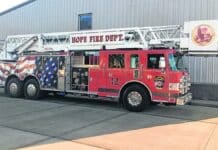Internationally renowned architect Eero Saarinen designed Dulles International Airport outside of Washington, D.C., to allow space for it to double in size after its 1962 completion.
But daughter Susan Saarinen mentioned that the late Modernist designer with three major buildings in Columbus would be saddened to see how his original, painstakingly researched airport layout to save travelers precious time and steps has been left behind — all by newer designers who created expansions that she and others said have created longer walks and more confusion for travelers.
“I walked from one end of the terminal to the other,” his daughter said of a trip about a decade ago. “And I (dejectedly) thought of my dad.”
Susan Saarinen, a Colorado-based landscape architect, was among three speakers and panelists during a 90-minute session, “The Past is Present,” Thursday evening at the Eero Saarinen-designed North Christian Church as part of the Exhibit Columbus four-day symposium focusing on art, architecture and design. The 2018 National Symposium: Design, Community and Progressive Preservation began Wednesday in Indianapolis and runs through today downtown at The Commons.
[sc:text-divider text-divider-title=”Story continues below gallery” ]Click here to purchase photos from this gallery
Near the end, the three panelists — Saarinen, Gustavo Araoz of the International Council of Monuments and Sites and Adrienne Heflich of Michael Van Valkenburgh Associates, Inc. — sat in noted designer Charles Eames’ chairs made for the building. Eames and Eero Saarinen worked together for a time on furniture design.
About 300 people attended, ranging from city leaders such as Mayor Jim Lienhoop and Columbus Area Visitors Center tour guides to symposium participants who traveled to Indiana for the programming.
The symposium has recorded 650 registrants, organizers said. But Landmark Columbus director Richard McCoy, among the symposium founders and leaders, said he expects about 1,500 people today at events open to the public.
Susan Saarinen last spoke in Columbus about her famous father in 1998 at the Columbus Area Visitors Center. Back then, she delightfully recalled climbing in and out of different cardboard boxes as a youngster in her dad’s office while her father timed her. She thought it was child’s play, but her father saw it as serious work while he designed the people pods for what would become the Gateway Arch in St. Louis, Missouri.
Saarinen is currently working on her memoirs and, when prodded, said she would be open to return to Columbus when her book is complete.
She drew applause Thursday when she opened the gathering, after rousing ethnic and Hoosier-flavored tunes from the Cummins Diversity Choir, with a simple, warm statement: “Welcome to my father’s church.”
The structure was completed in 1964, three years after the designer’s death while undergoing an operation for a brain tumor. The building was then the worship home of worldwide architectural leaders and supporters J. Irwin and Xenia Miller, who also have been part of the inspiration for Exhibit Columbus.
In the crowd was older brother Eric Saarinen, a Los Angeles-based filmmaker who spoke earlier in the day when he presented the documentary, “Eero Saarinen: The Architect Who Saw the Future.”
The celebrated architect was in some way the focus of each speaker’s remarks and perspective.
Heflich, for example, focused on reviving a segment of Saarinen’s landscape vision at the Gateway Arch with top landscape designer Dan Kiley. One way her firm, the same one that completed a makeover of Mill Race Park in Columbus in the early 1990s, helped restore the duo’s intent for the area around the soaring arch was to create a festival/gathering place that opened this summer for concerts and more as part of a larger $300 million project.
“This was part of keeping relevant the original designs of Saarinen and Kiley and reinvigorating those, and then bringing those designs to a new audience,” Heflich said after the gathering.
All session participants, including moderator Theodore Prudon, president of Docomomo U.S., emphasized that architectural leaders need to find ways to become or remain optimistic about the future of creative design.
That can be difficult in a modern world “of blue and yellow boxes instead of interesting shapes,” Susan Saarinen said.
Columbus artist and arts supporter Steven Newlin, who attended the session, said he was optimistic about the present and future of good design locally.
“The thing that really gives me hope about Columbus is that we really believe in finding ways of re-use,” Newlin said. “Look at the (Upland) Pumphouse. It has been so many different things in its long life. And yet, we never have talked about tearing it down. And even when they tore down the original Commons (in 2008), they kept the original frame and found a way to rebox it. So, we seem to be committed to finding a re-use for things.”
Such thoughts generated a comment on another historic building in downtown Columbus — one that’s 129 years old, has been closed for four years and has an uncertain future.
“I’m just hoping we can somehow do that for The Crump, too.”
[sc:pullout-title pullout-title=”Symposium schedule” ][sc:pullout-text-begin]
Today
9 to 10:30 a.m.: “Exhibition as Civic Action,” The Commons, 300 Washington St., presented by the Columbus Area Visitors Center. How do architecture, art and festivals communicate the unique qualities of communities and historic resources? Speakers: Laura Flusche, Museum of Design Atlanta; Gavin Kroeber, New Cities Future Ruins; Todd Palmer, Chicago Architecture Biennial. Moderator: Jennifer Dunlop Fletcher, San Francisco Museum of Art.
11 a.m. to 12:30 p.m.: “Introducing the 2018–19 Washington Street Civic Project Leaders,” The Commons, presented by the Columbus Area Visitors Center. Speakers: Paola Aguirre, Borderless Studio, Chicago; Chris Woebken, Extrapolation Factory, New York; Elizabeth Timme, LA-Más, Los Angeles; Michael Bricker, People for Urban Progress, Indianapolis; Carlos Zedillo Velasco, PienZa Sostenible, Mexico City. Moderator: David Rubin, DAVID RUBIN Land Collective.
2 to 3:30 p.m.: “Engaging the Next Generation,” The Commons, presented by the Council for Youth Development with special support from the Cornelius O’Brien Lecture Series. How can architects and designers involve future users and future creators in more inclusive conversations around design? Speakers: Sarah Urist Green, The Art Assignment; Yugon Kim, IKD; Mila Lipinski, University of Illinois; Matt Shaw, The Architect’s Newspaper.
4 to 4:30 p.m.: “Introducing the 2018–19 Image and Environmental Designer,” The Commons, presented by Johnson Ventures. Rick Valicenti of Thirst on power of graphic design to communicate, educate and tie together diverse elements into a cohesive and dynamic whole.
4:30 to 6:30 p.m.: “Introducing the J. Irwin and Xenia S. Miller Prize Recipients, The Commons, presented by the City of Columbus. Miller Prize winners: Gina Ford, Agency Landscape + Planning, Cambridge, Massachusetts; Bryony Roberts, Bryony Roberts Studio, New York City; Frida Escobedo, Frida Escobedo Studio, Mexico City, Mexico; Alan Ricks, MASS Design Group, Boston, Massachusetts, and Kigali, Rwanda; Jing Liu, SO-IL, New York City. Moderator: Sean Anderson, associate curator for the Department of Architecture and Design of MoMA, New York.
6:30 to 8:30 p.m.: Closing Party on Washington Street.
More information: exhibitcolumbus.org
[sc:pullout-text-end]




